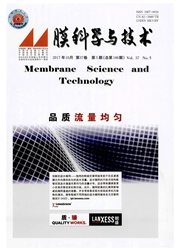

 中文摘要:
中文摘要:
以聚砜(PSF)为基膜,间苯二胺(MPD)和均苯三甲酰氯(TMC)为反应单体,通过界面聚合制备聚酰胺复合纳滤膜。考察了复合催化剂三乙胺(TEA)和樟脑磺酸(CSA)及反应条件,对纳滤膜功能层结构和性能的影响。结果表明:在反应体系中,TEA和CSA的物质的量比为1/2时,随着复合催化剂中TEA的用量从0.5 wt%增加到3 wt%,纳滤膜功能层密度增大,表面粗糙度和亲水接触角下降,膜通量明显升高,但纳滤膜的截留率及其对盐的选择顺序基本不变。在TEA含量为2 wt%,反应时间40 s,热处理温度80 °C,热处理时间3 min的最优条件下,所得复合纳滤膜对2 g/LMgSO4溶液的截留率为93.2%,通量为16 L/m^2h。在0.2-1.0 MPa的操作压力下,聚酰胺复合纳滤膜分离性能稳定。
 英文摘要:
英文摘要:
Polyamide thin-film composite membrane was prepared through interfacial polymerization between m-phenylenediamine (MPD) and trimesoyl chloride (TMC) on the polysulfone (PSF) support membrane. The effect of the composite catalyst (triethylamine (TEA) and camphorsulfonic acid (CSA) ), as well as the reaction conditions on the ultra-thin poly skin layer structure and performance of the nanofiltration membrane were systematically investigated. Results show that the the ultra-thin skin layer density increased, the surface roughness and the hydrophilicity contact angle decreased, and the water flux increased dramatically, while the changes to the rejection and the selecting sequence for salt of nanofiltration membrane have been very minor, as the TEA concentration in the composite catalyst increased from 0.5 wt % to 3 wt % and the molar ratio of TEA and CSA fixed at 1/2. When the concentration of TEA is 2 wt%, reaction time is 40 s, curing temperature is 80°C, curing time is 3 min,the composite nanofiltration membrane exhibited good performance that the rejection of 2 g/L MgSO4 solution was 93.2% , and the water flux was 16 L/m^2h. Polyamide thin-film composite separation performance was stable at 0.2 - 1.0 MPa.
 同期刊论文项目
同期刊论文项目
 同项目期刊论文
同项目期刊论文
 Preparation of PVDF membranes via the low-temperature TIPS method with diluent mixtures: The role of
Preparation of PVDF membranes via the low-temperature TIPS method with diluent mixtures: The role of Understanding PVDF ultrafiltration membrane fouling behavior through model solutions and secondary w
Understanding PVDF ultrafiltration membrane fouling behavior through model solutions and secondary w Preparation of PVDF hollow fiber ultrafiltration membrane via phase inversion/chemical treatment met
Preparation of PVDF hollow fiber ultrafiltration membrane via phase inversion/chemical treatment met Study on the effect of modified PVDF ultrafiltration membrane for secondary effluent of urban sewage
Study on the effect of modified PVDF ultrafiltration membrane for secondary effluent of urban sewage The effect of PVDF concentration on PVDF/woven tube composite membranes and the application of compo
The effect of PVDF concentration on PVDF/woven tube composite membranes and the application of compo ExperimentalStudy of Adhesion Properties Between Membrane Surface and Humic Acid DuringMicrofiltrati
ExperimentalStudy of Adhesion Properties Between Membrane Surface and Humic Acid DuringMicrofiltrati Mechanism analysis of membrane fouling behavior by humic acid usingatomic force microscopy: Effect o
Mechanism analysis of membrane fouling behavior by humic acid usingatomic force microscopy: Effect o Polyvinylidene fluoride/poly(ethylene-co-vinyl alcohol) blended membranes and a systematicinsight in
Polyvinylidene fluoride/poly(ethylene-co-vinyl alcohol) blended membranes and a systematicinsight in Enhancement and Mitigation Mechanisms of Protein Fouling of Ultrafiltration Membranes underDifferent
Enhancement and Mitigation Mechanisms of Protein Fouling of Ultrafiltration Membranes underDifferent 期刊信息
期刊信息
